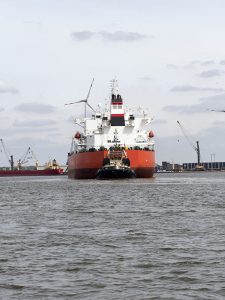This day saw us re – entering Belgium, via the Schelde – Rijn Canal. One easy lock,
https://www.youtube.com/watch?v=slUTOMf5Sro&feature=youtu.be
One of the reasons why a boat must be secured.
https://www.youtube.com/watch?v=r43zKDSKF_s&feature=youtu.be
and a lifting bridge or two made for an easy 40km or so motor.
Large ships were towed in by tug.
The building at the bridge that allows entrance to the Willemdock marina was an interesting amalgamation of architectural styles.
Gratis moored, bikes off, into the old city centre went we. The colossal size of the cathedral was a wow factor, as were the medieval buildings that encircled it.
This was an interesting display found on one of the building s at the marina.
Interesting Facts
- It has come to light that first habitation within the city’s limits was as early as the second to third centuries. Initially two settlements set a mere ½ a kilometre apart, over time the populations grew to such an extent that they merged to become one. As with Bergen op Zoom, Antwerp took its name from the sandy mound (‘aanwerp’) upon which it grew.
- With the silting of the Bruges port during the 1100s, Antwerp came into its own, becoming both the economic and trading centre of Europe within two hundred years.
- With the coming of Protestantism, religious upheavals took place and from 1650 – 1863, entry to the Scheldt River was prohibited, thereby creating an economic disaster. Despite this, thanks to its artists, printers and manufacturers of the harpsichords although the town became little more than a country town, it didn’t totally disintegrate.
- Antwerp is the second largest European port
- Here is the world hub for the uncut diamond trade







